How To Play Pool In 5 Steps? Beginners Guide To Playing Pool
Key Takeaways:
- Ready to start your game off right? Discover the essential steps for how to play pool—this is where your victory begins!
- Curious how top players control the cue ball? Learn about the 9 different shots every player should master and how proper cue stick handling makes all the difference.
- Want to step up your performance? Find out why choosing the right pool cue is the ultimate game-changer and how it can instantly improve your precision and power.
Step 1: Prepare for the game
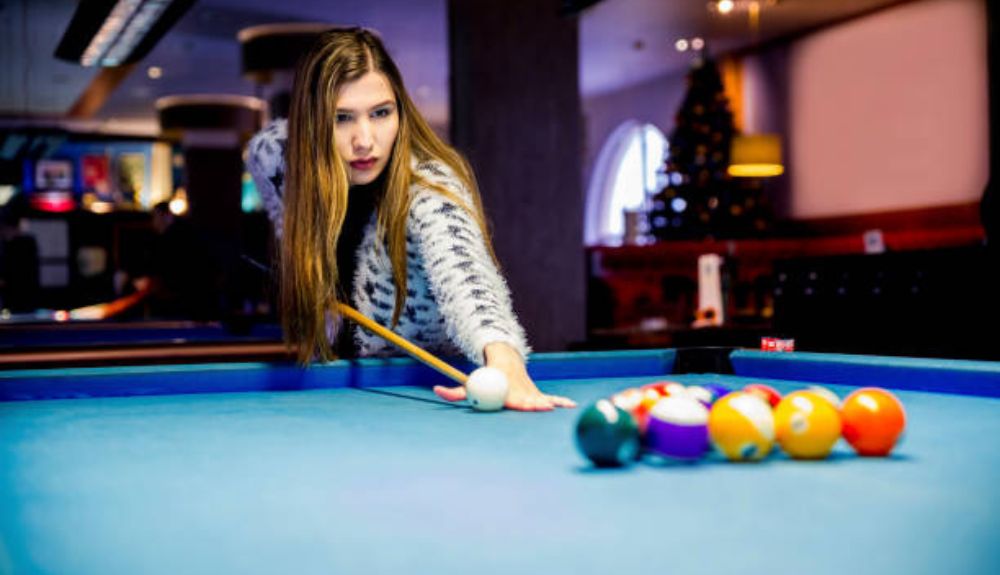
The first step to start playing pool is understanding all the involved rules and pieces of equipment.
Get familiar with the equipment and its anatomy
Pool cue
The pool cue is the most crucial piece of equipment in pool. Choosing a good pool cue helps you achieve your desired result, adding to the attraction and comfort of the game. Conversely, a bad pool cue will make your game slower and more frustrating. Pool cues can come in various sizes, weights, tips, and pricing, but there are two main types of pool cues that you need to consider based on your using purpose:
- 1-piece pool cue: Best used at home and in casual environments.
- 2-piece pool cue: Should be used by serious players who travel to play, such as those who participate in tournaments. When traveling, it’s advantageous to divide your cue into two pieces.
Another important part of a pool cue is the pool cue tip. Cue tip size and hardness also can affect your shots.
Pool table
The pool table is another important piece of equipment in pool. There are four standard sizes of pool tables on the market: 7 feet, 8 feet, 8.5 feet, and 9 feet. 7-foot tables are typically used in bars and as coin-operated tables. Household tables are typically 8 feet long; 8.5-foot tables are less common. 9-foot tables, which are the standard size for professional pool tables, are used in tournaments and billiards halls. The pool table is constructed from many different components with its functions, including cushions, slate, pockets, cloth, legs, bumpers, and rails,…The pool table normally has 6 pockets, different from Snooker and Billiard.
Pool ball
A full set of pool balls in pool has sixteen balls total, each measuring 2 1/4 inches in diameter, including a solid white “cue” ball, seven balls with a color stripe numbered nine to fifteen, and eight solid color balls numbered one to eight. The number of balls in a full set of pool balls varies depending on the type of game being played. The pool balls can be made from many different materials such as wood, ivory, cellulose, etc. However, the main material that people use nowadays is Phenolic resin which is easier to produce and reasonable in price.
Understand pool language
Before playing the game, you have to understand all pool terminology to communicate with the game partners. For example, the term “ break” in pool does not mean interrupt, it is the first shot at the beginning of the game to break up the fifteen pool balls with a cue ball. Or the term “scratch” means a situation when the cue ball rolls into a pocket or jumps off the table. Scratches cause you to lose your turn, and if you’re utilizing the ball-in-hand rule, they offer your opponent the ball in a very advantageous position.
Know the rules
There are 5 types of pool games with different rules: 8-ball, 9-ball, cutthroat, bumper, and one pocket pool. But the most popular pool game type is 8-ball pool. Here we discuss the rules of 8-ball pool as follows:
- The object balls should be arranged in a triangle rack at the lower end of the table before the game starts, with the ball at the top of the rack resting on the foot location. Except for the black 8-ball, which should be in the middle of the third row, the order of the balls should be random. Anywhere on the table behind the service line should be where you put the white ball.
- To determine who gets to choose whether to break in the first game of a match, a coin should be flipped. After then, take turns to make the break
- The player must strike the balls to make a legal break, ensuring that the cue ball doesn’t go into a pocket and that four balls hit the cushions. In the event that the 8-ball is potted during the break, the player may request a re-rack.
- The first player must continue to pot balls from that category after potting an object ball (stripes or solids). The other group must be potted by the opposing player.
- Up until they foul or miss an opportunity to put the ball in play, a player will continue to make shots. Then it is the opponent’s turn to play. The rest of the game is played in this manner.
- A player must sink the 8-ball after all of their balls have been potted. The pocket in which they want to pot the 8-ball must first be specified, and only then may they proceed as directed. The opposing player will return to the table if this is not done. The player loses if they pot the 8 ball in a pocket that is not the designated one.
Step 2: Rack the pool balls
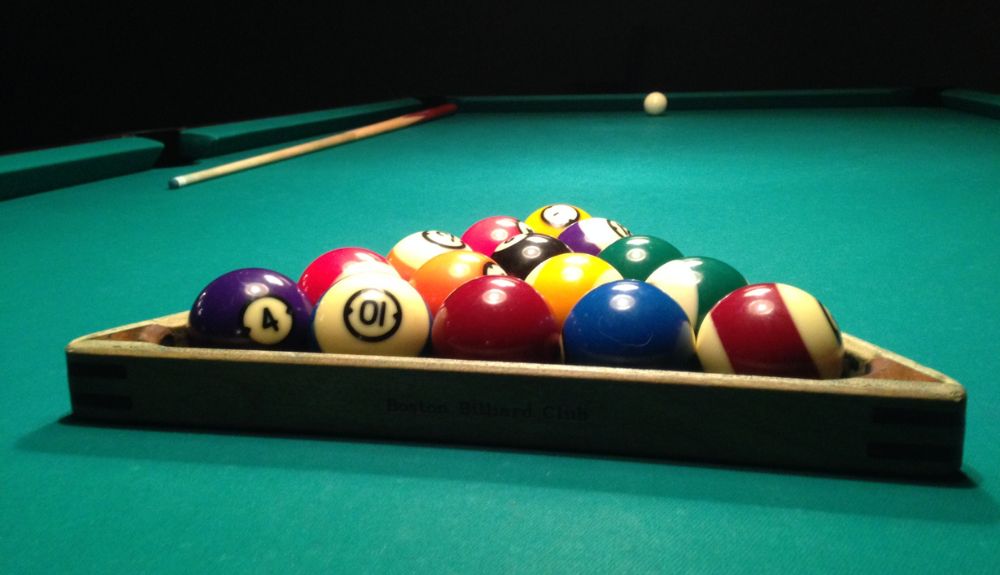
Making a rack is needed at the beginning of the game and before the break. All you have to do is put all 15 pool balls on the rack. Place the eight-ball in the middle of the rack. In one corner, place a solid ball, and in the other corner, place a striped ball. Make sure that 15 balls are properly racked and that they are all in contact with one another since a slight space between two balls can wreck your strategy by reducing the force of impact.
Step 3: Holding a pool stick properly
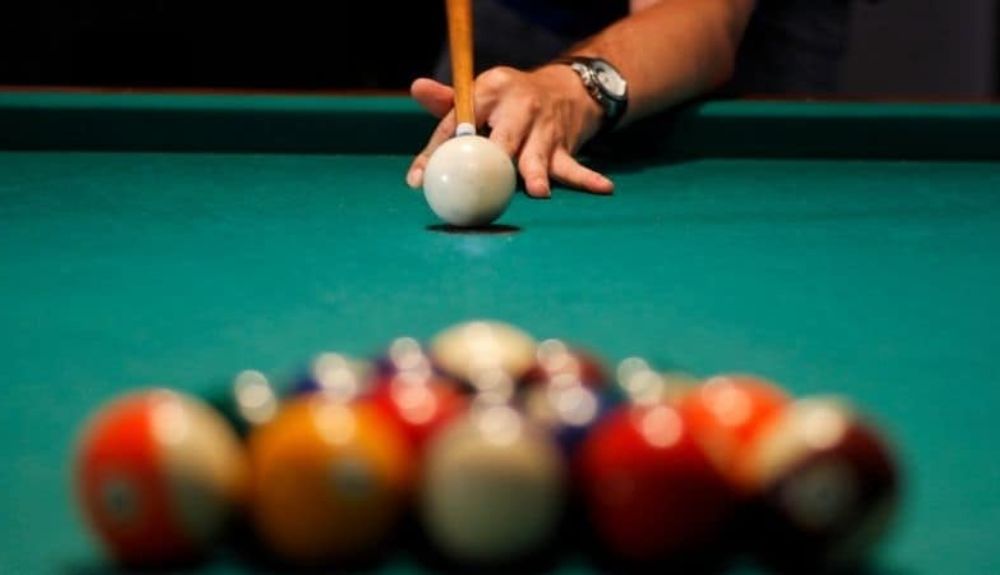
The way you hold the pool stick and your position will significantly affect the shot. Here are some ways to hold a pool stick properly:
- Grab the cue with a comfortable hand close to your waist.
- Your upper body should be lowered to the table.
- Use your other hand to cradle or bridge the cue’s tip.
The key to a great shot is holding the cue stick in a way that provides stability and enough movement. Building a solid bridge requires a lot of skill. There are 5 types of bridge techniques that you can learn to make, including open, close, rail, elevated, and mechanical bridges depending on your shots. These bridge types can be applied in different shots and purposes.
Step 4: Make the shots
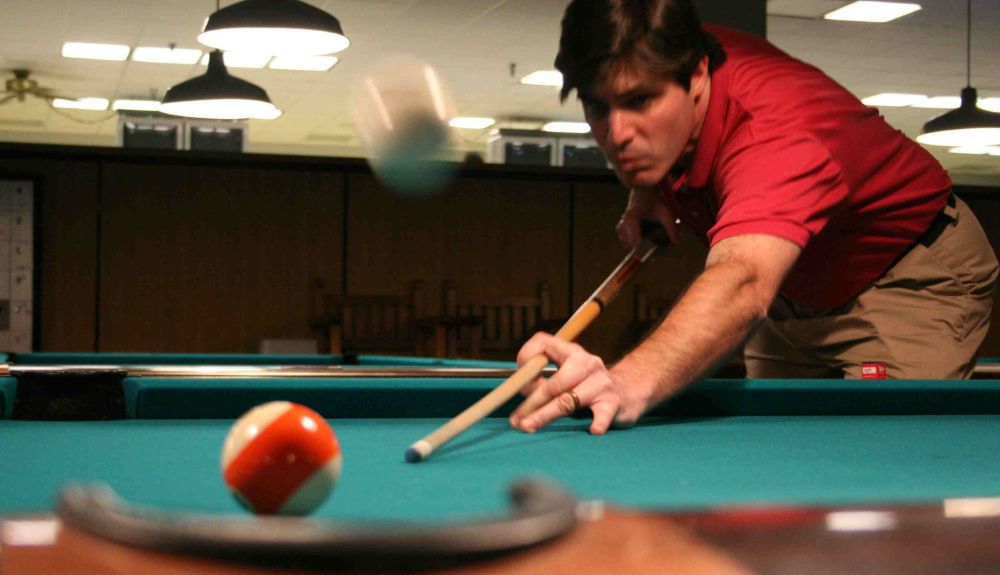
Break shot
Breaking a rack is crucial because it can influence how the rest of the game will go. Although it seems straightforward, learning how to break in pool is challenging because you must take into account a variety of factors, including ball position, hand and body position, targeting, and more.
After all the pool balls are racked correctly, get into the position in which you feel comfortable. Positioning one foot in front of the other in line with your pool cue. If you take a wider stance, you’ll feel more secure. Get your chin close to your pool cue while bending your knees. The ideal option for breaking is a closed bridge since it allows you to fire stronger bullets while retaining a smoother, more supported stroke. You just need to place the pool cue tip between your thumb and index finger in the center. Your index finger should be curled around the cue. Then, with your thumb, make a circle around the shaft with your index finger. To gain more stability, spread your fingers wider. Aim slightly below the ball’s center, so it doesn’t roll back too far towards you once it makes contact, and then make the shot. For breaking, a closed bridge is the greatest option since it enables you to fire more powerful bullets while yet maintaining a smoother, more supported stroke. Looking for the best break cue? Visit here!
Straight shot
The straight shot is the next and most fundamental kind of shot you may make in pool. It all comes down to aligning the cue, cue ball, target ball, and pocket in a single straight line. The goal is to strike the target ball dead center with the cue ball and cause the target ball to roll straight towards the pocket after being struck dead center with the cue ball.
You should modify your force following the distances between the target ball and the pocket as well as the distance between the cue ball and the target ball. A pro tip for making straight shots is to stop your pool cue almost immediately after it makes contact with the cue ball.
Jump shot
To make the ball jump or fly, you must use this technique and a good jump cue. If a ball needs to be cleared out of the way so that your cue ball can hit your target ball, then this shot is advantageous. The pool cue must be held at a somewhat acute angle, facing the cue ball downward at around 45 degrees, to make a jump shot. The goal is to use a downward motion to strike the ball just above the middle, just above the midway point, however, you should strive to hit it forward a little bit as well.
Curve shot
The curve shot is one of the pool shots that demands a little more expertise. The goal of this stroke, as you might have guessed, is to get the ball to go in an arc rather than a straight path. This can come in handy if you need the ball to curve to strike the target ball, say if another ball is in the way or if there isn’t a clear shot into the pocket.
You must strike the ball with a forward and downward motion to make a curve shot. You must strike the ball hard and quickly, and you must do so to one of the sides rather than directly in the center. Keep in mind that the goal of this shot is to give the ball a lot of spin, which is accomplished by striking it forcefully and off-center. The direction you need the ball to spin in determines which side you strike it on.
Slip shot
The slip stroke or slip shot is another excellent pool shot style to learn. In order to execute this shot, you must move your gripping hand—the one that is attached to the pool cue handle—backward during the last stroke.
To put it another way, when you make your final pull-back and are about to strike the cue ball, you briefly release the cue, bring your hand back toward the handle, then re-grasp it and make the shot.
The goal of this kind of stroke is to give you considerably greater follow-through with both the cue and the ball so you can better guide it.
Angled shot
The angled shot is the best option when the target ball does not form a straight line with the cue ball and your cue, but you have a clear, unobstructed line of sight between the cue ball and the target ball. In other words, for the target ball to move at an angle toward the pocket, the cue ball must strike the target ball at an angle. It takes some planning to execute the angled shot since the cue ball must strike the target ball precisely for it to move at the appropriate angle toward the pocket. In other words, the cue ball must strike the target ball to the right of its center if you want it to move at an angle to the left.
Force follow shot
This type of shot is about striking the cue ball as hard as possible just above the center point to give the cue ball as much forward spin as possible. The cue ball’s forward spin causes it to continue moving forward after making contact with the target ball, which means that it will eventually follow the ball forward and may even hit another ball. This is not only a good way to knock two balls with one shot, but it also enables you to position the cue ball perfectly for the following shot.
Draw shot
Similar to the force follow shot we discussed before, the draw shot involves hitting the ball slightly below the center rather than forcefully and above it. This shot is intended to give the ball backspin.
As a result of the backspin, the cue ball should move back towards you as soon as it strikes the target ball in this manner. If you need to sink a ball that is very close to a pocket and you don’t want to take the chance of sinking the cue ball, this is a good shot to know. Additionally, it works well for getting the ball to come back your way and setting up your next shot.
Bank shot
Actually, one of the simpler and most frequent kinds of shots in pool is a bank shot. Typically, this shot does not spin. It all comes down to hitting the target ball with the cue ball dead center. The target ball should then strike a rail, bounce off the rail, and fall into a pocket.
Step 5: Choose Top-rated Pool Cue to upgrade your game
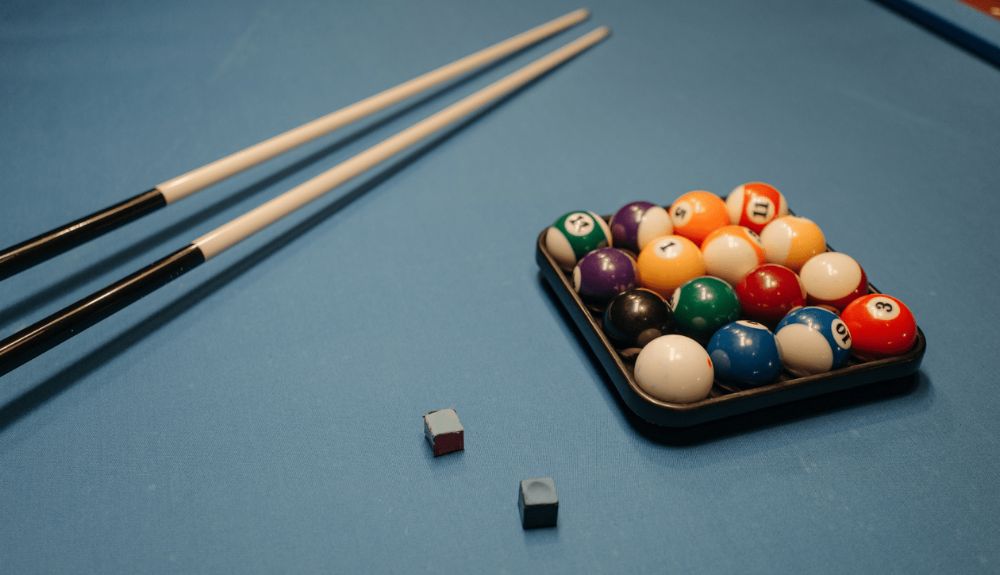
Choosing a good pool cue is important since it can affect your shots. There are so many good pool cues in the market that you can choose to improve your game. However, you should choose the one within your budget and suitable for your playing experience. Here we can list the top 5 pool cues in 2022 as follow:
Pool cue name | Feature | Price |
Pearson World Record Limited Edition 1 Pool cue |
| Around $1,195 |
Lucasi Hybrid LHC97 Natural Birds-Eye Maple Pool Cue |
| Around $890 |
Players Technology Series HXT15 Two-Piece Pool Cue |
| Around $259 |
Viper Signature 57″ 2-Piece Realtree Camouflage Billiard/Pool Cue |
| Around $46 |
Champion Sports White Spider Maple Pool Cue Stick |
| Around $100$ |
FAQs
What are the differences between 8-ball and 9-ball pool?
8-ball and 9-ball are two different pool game types with different rules and numbers of balls.
The 8-ball pool is played with 16 numbers balls with numbers 1 through 7 being solid colors and numbers 9 through 15 being stripped. The eighth ball is black and is occasionally referred to as blackball. Moreover, there is a cue ball, which is normally white. To win the 8-ball game, you must first pot the 8-ball into a called pocket after pocketing all of your assigned balls.
The 9-ball pool is played with 10 numbered balls. Both the ball’s colors and the patterns don’t matter. The balls are numbered from 1 to 9, and the set is completed by a white cue ball. The player who successfully pockets the 9-ball at any time during the game is declared the winner.
Can I hit the 8 ball first?
If you are playing 8-ball pool, you can not hit the 8-ball first. The rule of 8-ball pool is that you have to pocket all your balls(solid color balls or striped balls) first, and the last aim is the 8-ball. The winner is the first person to initially pocket the 8-ball after pocketing all of their balls.
What is a double kiss in pool?
In pool, a double kiss occurs when the cue ball and an object ball make two contacts in a single shot. Due to the difficulty in predicting the direction that the cue ball and object ball will go in after the second kiss, the majority of pool players strive to avoid double kisses. It takes a lot of practice before skilled players can predict the outcome of a double kiss.
What is a foul in pool?
Foul happens in these situations:
- Failing to hit your object balls.
- Hitting the cue ball off the table.
- Potting one of the opposition’s object balls.
- Hitting the cue ball twice.
- Pushing the cue ball rather than striking it.
- A player takes a shot when it is not their turn.
In general, the four fundamental procedures outlined above make it simple to grasp how to play pool. But much as in other sports or gaming genres, practice makes perfect. After a few humbling experiences, you’ll get better. If you are passionate about pool, being aware of how the equipment, pool table rules, and different shot types affect the game will help you manage and improve your matches.
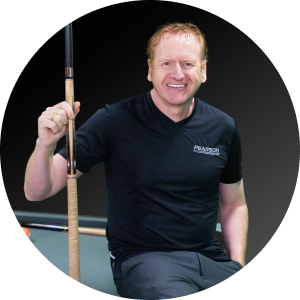
Dave Pearson
Dave Pearson, the world's leading pool entertainer, is renowned globally as the ultimate exhibition player.
Boasting 20 world records endorsed by the prestigious Guinness Book of World Records, Dave established a legendary history in the sport industry.
